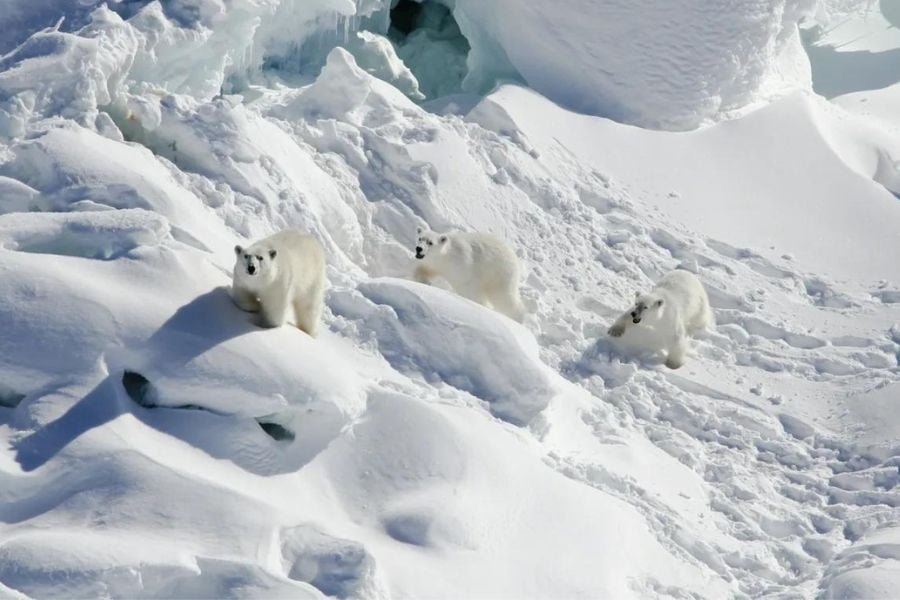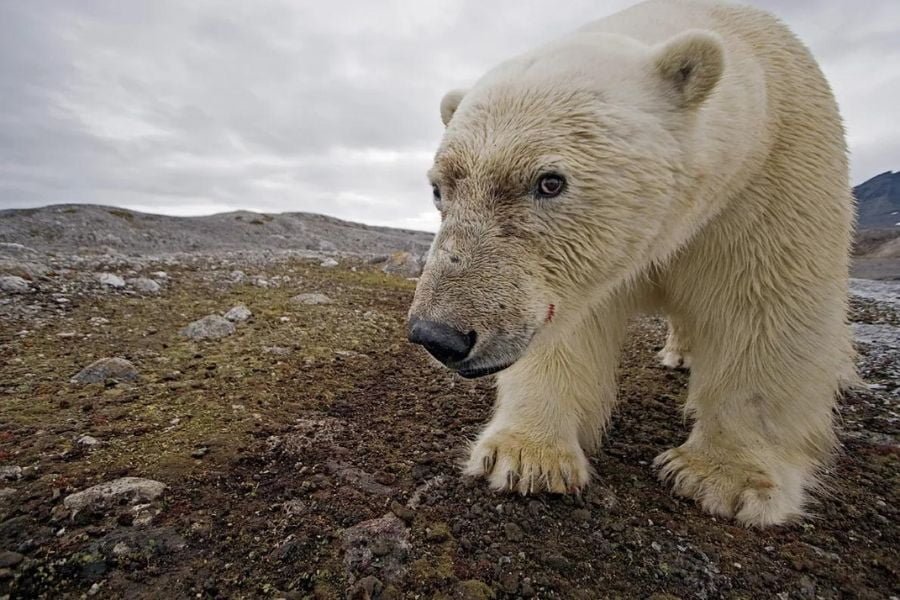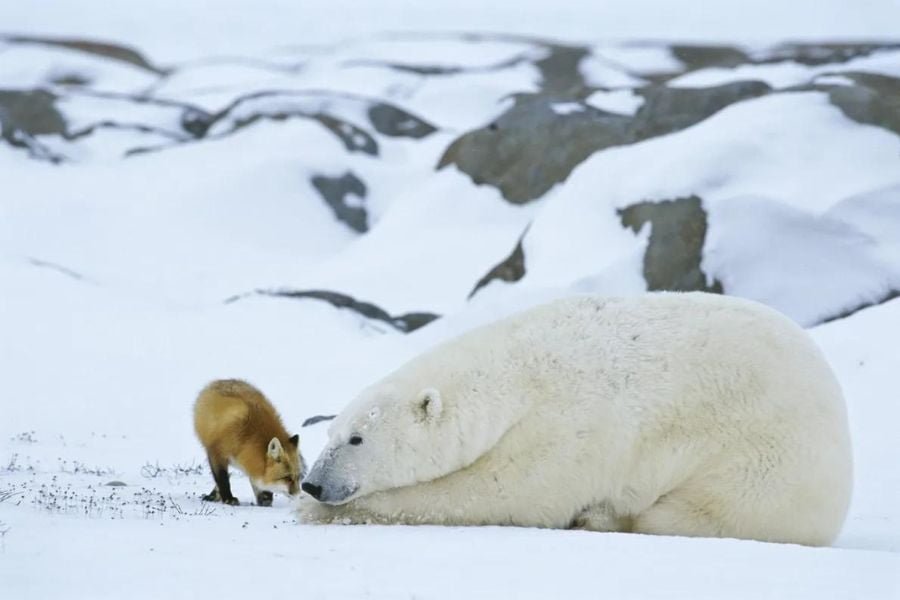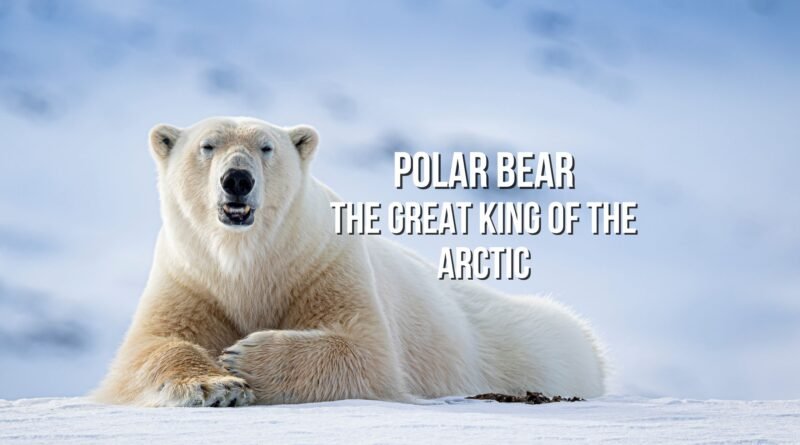Polar bear: the great king of the Arctic
Giant wanderer and solitary. Often seen wandering alone through the white and icy Arctic immensity, where does the polar bear live. It impresses with its beauty and size. Let’s get to know a little more about the largest terrestrial carnivore. Enjoy the reading and have fun!

Polar bear features
Considered a marine mammal and still classified as the largest terrestrial carnivore. How is this possible? The explanation is simple: it lives both in the sea and on land, however, its primary environment is water. Therefore, it is a marine animal.
In this species, as well as in many others in nature, there is sexual dimorphism: males and females have different sizes. The adult male polar bear can be, on average, 6 to 10 feet long and weighs 700 to 1,500 pounds. The females, on the other hand, measure between 5 and 8 feet and weigh 770 to 1,100 pounds. Sexual dimorphism is also shown in the size of the teeth and dental arch, which are larger in males.
The difference in size exists not only between males and females. But also exists between individuals from different locations due to what is called clinal variation. The largest male bear on record weighed a ton when he was shot in northwestern Alaska in 1960.

Fur
Did you know that its skin is black? Exactly! The polar bear’s skin is black, so it is easier to capture and retain the heat from sunlight. It keeps the animal warm amid so much ice where does the polar bear live. Amazing, isn’t it? Although we see them as white, their fur is transparent. The white color is a result of light reflecting off their fur. To help with thermal insulation, its fur is made up of a 2 inches layer of hair. Also an outer layer with up to 6 inches of hair. It can vary in color from yellowish to gray, depending on the time of year.
In addition to the fur, the polar bear also has a layer of fat up to 4 inches thick to help protect it from the cold. Indeed, it all seems to have been planned for that. Perhaps the natural evolution and adaptation to the environment in which it lives made the polar bear that way. Its paws are up to 12 inches in diameter, are very large, and help it to walk on ice.

Habitat
Where does the polar bear live? As we can already imagine, polar bears inhabit the so-called Arctic Circle. Also, it lives in its neighboring continental areas, including Canada, Greenland, Norway, Russia, and the USA (Alaska). Canada alone is home to about 60% of the world’s population of polar bears.
As mentioned at the beginning of this article, these animals are considered solitary and wanderers. They do not remain in one place their whole life, frequently seen roaming over large areas. The polar bear is like this because it always prefers to stay close to places where ice meets water. In these places seals are abundant, its favorite food.
They are excellent swimmers, able to stay underwater for up to two minutes. They swim long distances, sometimes for hours, even in open water.
Diet
In the Arctic, where does the polar bear live, it can’t find plant species, so its diet is entirely carnivorous. By the way, do you remember that we said that it is the largest terrestrial carnivore? Yeah, the polar bear is huge, and without natural predators. It is the great king of the Arctic!
It feeds mainly on seals, but other animals are part of its diet. Salmon, belugas, walruses, whale carcasses, and other fish, in general, are on its menu.

Fun fact: Do you know why polar bears don’t eat penguins?
Because, despite the many images in which they appear together, they live on opposite sides of the globe. Where does the polar bear live? Polar bears live at the North Pole in the Arctic, while penguins live at the South Pole in Antarctica. 🙂

Behavior
Except for the breeding season and a few others in the year, the polar bear’s behavior is solitary. They are only seen in packs to breed. Also, they are seen together in late spring and early summer when seals are most abundant. Other than that, they are always alone.
More than 50% of their time is spent hunting, and this requires enormous effort on their part. Their prey, which makes up their diet, is extremely agile. To be able to hunt fish, the polar bear is an excellent swimmer and can reach a speed of 6 mph. In the case of seals, the polar bear digs holes in the ice and patiently waits. When its prey comes to the surface to breathe, it catches it. When it hunts land animals, its technique is to silently approach colonies or nests. You can see that it is an excellent hunter, right?
Unlike its land bear relatives, the polar bear does not hibernate, except for pregnant females.

Reproduction
As we mentioned earlier, the breeding season is one of the few times when polar bears are highly sociable. It is common for males to compete with each other for females. They are polygamous animals, however, during pregnancy, the male stays with the female.
Gestation lasts between 195 and 265 days. At the beginning of this period, they intensify their diet, increasing their weight by up to 440 pounds. When the time comes to give birth, the females take cover in places they have prepared in advance. They enter these tunnels dug in the ice and go into a state of hibernation. During the time they are hibernating, they do not feed and maintain themselves only with accumulated body fat. They will only feed again after the cubs are born.
From each gestation, two cubs are usually born, however, it is possible to be born from 1 to 3. The cubs are born with around 1,300 pounds, without teeth, blind, and with very thin fur, without thermal insulation. Because of this, they remain inside the den, along with their mother who nurses them for about 4 months. The mother, in a state of almost hibernation, does not feed itself. It survives on its reserves. When they leave the dens, the cubs already weigh an average of 33 pounds. They remain with their mother, who will teach them to hunt, feed and survive until they are about 2 years old.

Conservation status
Unfortunately, the situation of the polar bear is extremely worrying. It is listed as vulnerable on the IUCN (International Union for Conservation of Nature) Red List of Threatened Species.

Climate changes
Currently, the greatest threat to the polar bear’s survival is climate change. The melting of its habitat is due to rising temperatures. The population of this magnificent animal is suffering drastically from the melting of the North Pole ice sheets, which are causing the following problems:
- decrease in the amount of prey that provides their food;
- decrease in the areas where it is possible to build their dens;
- decrease cub survival rates;
- increase cases of cannibalism due to starvation;
- increase in cases of death by drowning.
Other factors that contribute to the vulnerability of the polar bear’s conservation status are:
Hunting
Native Arctic populations hunt them for their meat, fur, and even for crafts. In fact, by capturing and killing an animal, all of it is ‘used’, being a form of livelihood for these communities. Canada, Greenland, and Alaska have regulated polar bear hunting, but in Norway and parts of Russia, it is prohibited.
Oil spill
In addition to the obvious, that is the contamination of their food sources, oil spills also impair the thermal insulating function of the polar bear’s skin.

Conclusion
It is estimated that in a maximum of 80 years, almost all polar bear populations will have disappeared. But until that happens, they suffer from starvation. Their hunting area decreases by 13% every decade. This gives us a glimpse that these animals will soon run out of habitat and food. When the sea is not frozen, they are forced to stay on dry land and thus cannot hunt for food. The polar bear is dependent on the frozen sea to survive.
This extinction situation is still reversible and each of us can do a little to help. Recycling, reusing, buying products with refills, planting trees, saving electricity, not wasting water, and using returnable bags are actions in our daily lives that will contribute to the improvement of the environment as a whole in the long term. Caring for nature benefits all living beings, including us and polar bears. We count on you for this battle. Are you with us?




